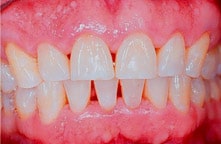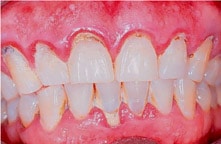Deena’s degree in Dental Medicine is from the University of Pennsylvania and her advanced degree in Periodontics and Dental Implants is from the University of Detroit Mercy School of Dentistry. She is a Diplomate of the American Board of Periodontology and trained in intravenous sedation and Advanced Cardiac Life Support. Deena is board certified in Periodontics both in the United States and Canada. Deena completed a general practice residency at the Albert Einstein Healthcare Network in Philadelphia and has practiced periodontics in Michigan. She is an active member in the Alpha Omega Dental Fraternity having served as Chapter President. Deena has achieved multiple honors and awards during her educational career.
PERIODONTAL SURGERY
SOFT TISSUE GRAFTS
Periodontal procedures are available to stop further dental problems and gum recession, and/or to improve the esthetics of your gum line. Exposed tooth roots are the result of gum recession. Perhaps you wish to enhance your smile by covering one or more of these roots that make your teeth appear too long. (see figure 1) Or, maybe you’re not bothered by the appearance of these areas, but you cringe because the exposed roots are sensitive to hot or cold foods and liquids.
Why do I need crown lengthening?
Periodontal procedures are available to lay the groundwork for restorative and cosmetic dentistry and/or to improve the esthetics of your gum line. Do you feel your teeth look too short and your smile is too gummy or your gums cover too much of some teeth while leaving the others the right length? Your teeth may actually be the proper lengths, but they’re covered with too much gum tissue. To correct this, your periodontist performs crown lengthening. This can be done to one tooth, to even your gum line, or to several teeth to expose a natural, broad smile.
What are the benefits of crown lengthening?
Whether you have crown lengthening to improve function or esthetics, patients often receive the benefits of both: a beautiful new smile and improved periodontal health – your keys to smiling, eating and speaking with comfort and confidence. This patient required a crown to protect a cracked tooth. However, the tooth was too short for the crown to fit. A crown lengthening allowed more tooth structure to be made available for the crown
What is the tratment for Periodontal Disease?
Once your periodontal health has been evaluated, we will work with you to determine the treatment options that are best to arrest your disease and bring you back to health. Depending on how far the diseases have progressed, treatment can vary widely. If caught in the early stages, simple procedures are done that will remove the plaque and calculus from below the gum line and eliminate the infection-causing bacteria. If the diseases have advanced to the point where the periodontal pockets are deep and the supporting bone is lost, further treatment might be needed. Whatever the treatment may entail, the goal is to return you to good oral heath and then help you maintain it. Benefits of periodontal treatment include:
- Elimination / control of infection
- Regrow lost bone tissue (bone grafts / regeneration)
- Retain teeth
- Fresh breath
- A more youthful appearance

Before

After
WHAT IS MAINTENANCE THERAPY?
Maintenance therapy is used to help prevent further infection from occurring in patients who have already received periodontal treatment. Dr. Frankel will tailor a program to fit your needs, which will include periodontal checkups, plaque and tartar removal and sometimes polishing your teeth or checking your bite. The frequency of visits varies from case to case from every few weeks to four times per year.
IF I HAVE PERIODONTAL DISEASE, DO I NEED SURGERY? WHAT ARE MY OPTIONS?
Whether you need surgery or not will depend on how advanced your periodontal disease is. There are non-surgical treatments, such as root scaling and planing available, for those with mild gum disease. If you are in the advanced stages of gum disease, you may benefit from having surgery. With the latest technology and advanced techniques available today, many surgical procedures can be performed in an office setting with little discomfort.
ARE DENTAL IMPLANTS THE BEST RESTORATION OPTION?
Your periodontist, Dr. Frankel, can determine if dental implants are the best restoration option for your individual case. Dental implants have a natural look and feel and can help prevent shifting of surrounding teeth. Implants are often preferred to bridges and dentures because they are more secure. The average life span of a bridge has been shown to be between 7 to 10 years. Dental implants have been shown to last much longer than a bridge and in many instances will last a life time.
WHY DO I NEED A RIDGE AUGMENTATION?
Sometimes when you lose one or more teeth, you can get an indention in your gums and jawbone where the tooth used to be. This happens because the jawbone recedes when it no longer is holding a tooth in place. Not only is this indentation unnatural looking, it also causes the replacement tooth to look too long compared to the adjacent teeth. This may even affect the way you speak if it involves a front tooth.
A periodontist can fill in this “defect” with a procedure called a ridge augmentation, recapturing the natural contour of your gums and jaw. A new tooth can then be created by your dentist that is natural looking, easy-to-clean, and beautiful.
WHY DO I NEED PLASTIC SURGERY?
Periodontal procedures are available to stop further dental problems and gum recession, and/or to improve the esthetics of your gum line. Exposed tooth roots are the result of gum recession. Perhaps you wish to enhance your smile by covering one or more of these roots that make your teeth appear too long. Or, maybe you’re not bothered by the appearance of these areas, but you cringe because the exposed roots are sensitive to hot or cold foods and liquids.
Your gums may have receded for a variety of reasons, including aggressive tooth brushing or periodontal disease. You may not be in control of what caused the recession, but prior to treatment your periodontist can help you identify the factors contributing to the problem. Once these contributing factors are controlled, a soft tissue graft procedure will repair the defect and help to prevent additional recession and bone loss. Soft tissue grafts can be used to cover roots or develop gum tissue where absent due to excessive gingival recession. This can be done for one tooth or several teeth to even your gum line and reduce sensitivity.
I HAVE A “GUMMY” SMILE. WHAT CAN BE DONE TO CORRECT THIS?
A procedure called esthetic crown enhancement can correct “gummy” smiles. “Gummy” smiles make teeth appear too short because either the gum and/or supporting bone did not passively repositon lower around the tooth after its eruption into the mouth. With esthetic crown enhacement, the gums and supporting tissues are reshaped/repositioned to expose the natural length & form of the tooth.


